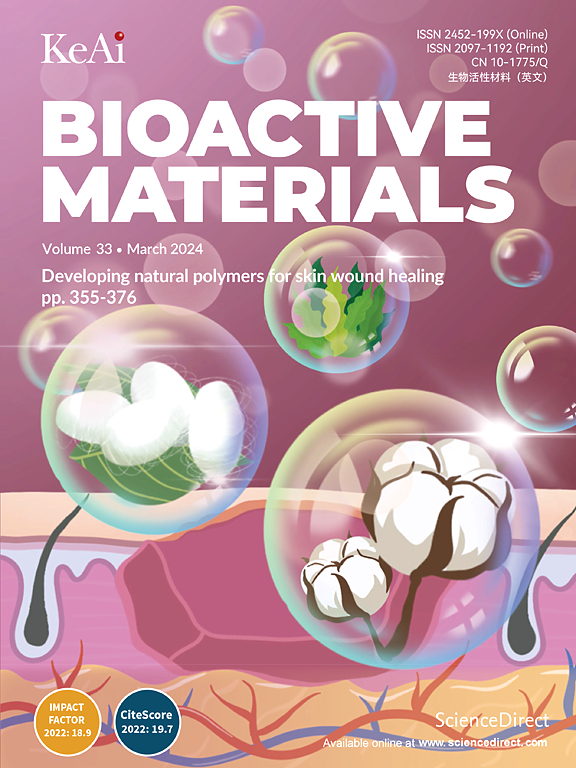MSAB limits osteoarthritis development and progression through inhibition of β-catenin-DDR2 signaling
IF 18
1区 医学
Q1 ENGINEERING, BIOMEDICAL
引用次数: 0
Abstract
The aberrant activation of the canonical Wnt/β-catenin signaling has been identified as a significant contributor to the pathogenesis of osteoarthritis (OA), exacerbating OA symptoms and driving OA progression. Despite its potential as a therapeutic target, clinical translation is impeded by the lack of a targeting delivery system and effective drug candidate that can modulate steady-state protein levels of β-catenin at post-translational level. Our study addresses these challenges by offering a new approach for OA treatment. To overcome these challenges, we introduced a novel delivery system using human serum albumin (HSA) to deliver a small molecule β-catenin inhibitor, Methyl-Sulfonyl AB (MSAB). This system is designed to enhance the bioavailability of MSAB, ensuring its accumulation inside the joint space, and facilitating the degradation of β-catenin protein. We have demonstrated that MSAB, when delivered via HSA, not only effectively inhibits cartilage damage but also ameliorates OA-related pain in an OA mouse model. We then performed proteomic analysis and biochemical studies to determine the molecular mechanisms underlying the therapeutic effects of MSAB. We identified that discoidin domain receptor 2 (DDR2), a critical mediator in OA pathology, is a downstream molecule of β-catenin signaling and β-catenin/TCF7 directly controls DDR2 gene transcription. MSAB suppressed the DDR2 expression in chondrocytes. MSAB ameliorated OA progression and OA-associated pain through inhibition of β-catenin-DDR2 signaling. This study underscores the efficacy of MSAB/HSA in OA treatment, providing new insights into its molecular mechanism of OA. It suggests that targeted therapies with MSAB/HSA could be a new OA management strategy.

MSAB通过抑制β-catenin-DDR2信号传导来限制骨关节炎的发展和进展。
典型Wnt/β-catenin信号的异常激活已被确定为骨关节炎(OA)发病机制的重要因素,加剧OA症状并推动OA进展。尽管其作为治疗靶点具有潜力,但由于缺乏靶向递送系统和有效的候选药物来调节β-catenin在翻译后水平的稳态蛋白水平,临床翻译受到阻碍。我们的研究通过提供OA治疗的新方法来解决这些挑战。为了克服这些挑战,我们引入了一种新的递送系统,使用人血清白蛋白(HSA)递送小分子β-连环蛋白抑制剂甲基磺酰基AB (MSAB)。该系统旨在提高MSAB的生物利用度,确保其在关节空间内的积累,并促进β-catenin蛋白的降解。我们已经证明MSAB,当通过HSA输送时,不仅有效地抑制软骨损伤,而且改善OA小鼠模型中OA相关的疼痛。然后,我们进行了蛋白质组学分析和生化研究,以确定MSAB治疗效果的分子机制。我们发现盘状蛋白结构域受体2 (DDR2)是OA病理的关键介质,是β-catenin信号传导的下游分子,β-catenin/TCF7直接控制DDR2基因的转录。MSAB抑制软骨细胞中DDR2的表达。MSAB通过抑制β-catenin-DDR2信号传导改善OA进展和OA相关疼痛。本研究强调了MSAB/HSA在OA治疗中的作用,为其OA的分子机制提供了新的见解。提示MSAB/HSA靶向治疗可能是一种新的OA治疗策略。
本文章由计算机程序翻译,如有差异,请以英文原文为准。
求助全文
约1分钟内获得全文
求助全文
来源期刊

Bioactive Materials
Biochemistry, Genetics and Molecular Biology-Biotechnology
CiteScore
28.00
自引率
6.30%
发文量
436
审稿时长
20 days
期刊介绍:
Bioactive Materials is a peer-reviewed research publication that focuses on advancements in bioactive materials. The journal accepts research papers, reviews, and rapid communications in the field of next-generation biomaterials that interact with cells, tissues, and organs in various living organisms.
The primary goal of Bioactive Materials is to promote the science and engineering of biomaterials that exhibit adaptiveness to the biological environment. These materials are specifically designed to stimulate or direct appropriate cell and tissue responses or regulate interactions with microorganisms.
The journal covers a wide range of bioactive materials, including those that are engineered or designed in terms of their physical form (e.g. particulate, fiber), topology (e.g. porosity, surface roughness), or dimensions (ranging from macro to nano-scales). Contributions are sought from the following categories of bioactive materials:
Bioactive metals and alloys
Bioactive inorganics: ceramics, glasses, and carbon-based materials
Bioactive polymers and gels
Bioactive materials derived from natural sources
Bioactive composites
These materials find applications in human and veterinary medicine, such as implants, tissue engineering scaffolds, cell/drug/gene carriers, as well as imaging and sensing devices.
 求助内容:
求助内容: 应助结果提醒方式:
应助结果提醒方式:


